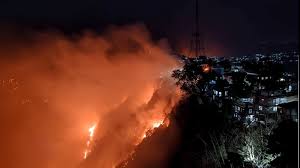
A series of forest fires that broke out last month in Mizoram’s Phawngpui National Park have scorched nearly one-ninth of the park’s total area, officials from the state forest department confirmed on Thursday. The fires reportedly originated on March 11 at a jhum (slash-and-burn) cultivation site in Archhuang village and quickly spread into the ecologically sensitive forest zones of the national park.
Though authorities have ruled out the possibility of a larger wildfire, the damage is significant. “The total area of Phawngpui National Park is about 50 square kilometres. Our preliminary assessment using satellite maps and online tools indicates that roughly one-ninth of the park has been impacted,” said Laltlanhlua Zathang, Chief Wildlife Warden of the Environment, Forest & Climate Change Department.
The flames were eventually brought under control by March 28, thanks to the tireless efforts of villagers from nearby communities such as Sangau, Sentetfiang, Thaltlang, Vawmbuk, Archhuang, Siachangkawn, and Cheural. “Despite the difficult terrain and the scale of the fire, villagers formed fire lines and worked relentlessly,” said LZ Ringlawt, Secretary of the Sangau Group Young Lai Association.
According to the Forest Survey of India, the fires were detected in 19 locations across the park, including the entire northern face of Mount Phawngpui—the highest peak in Mizoram—and the Far Pak grasslands, both of which were severely damaged.
Forest officials believe that a combination of sudden climatic changes, rapid growth of dry grass, and an accumulation of combustible material contributed to the rapid spread of the fire. Fortunately, no animal deaths have been reported so far. However, conservationists are concerned about long-term ecological consequences.
The Phawngpui National Park and adjoining forest areas in Myanmar are the only known habitats for the critically endangered Mount Victoria Babax, a ground-dwelling bird species unique to this region.
“This is the worst wildfire I’ve seen in my 30 years of service,” Zathang added, recalling a similar but less intense fire in 2012.
Environmental groups across Mizoram have expressed grave concern. “Wildfires cause irreversible harm—destroying habitats, killing wildlife, degrading soil quality, and releasing pollutants that endanger both human and animal health,” said SR Rothuama, General Secretary of the Green Mizoram Network.
Gunjan Arora, an environmental activist and bird watcher from New Delhi who recently visited Phawngpui, said the timing of the fires could have devastating effects. “With nesting and mating season approaching, the destruction of habitats and food sources poses a serious threat to the survival of many species,” Arora noted.
Forest fires caused by jhum cultivation remain a recurring problem in Mizoram, highlighting the urgent need for sustainable agricultural practices and enhanced forest fire management.
Sources By Agencies

